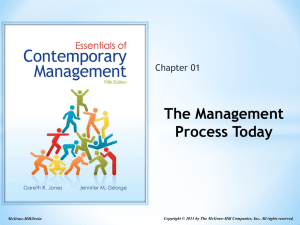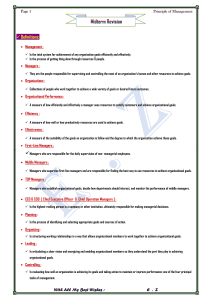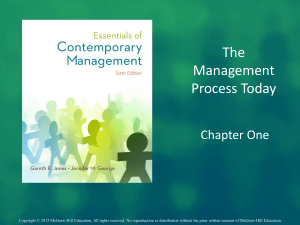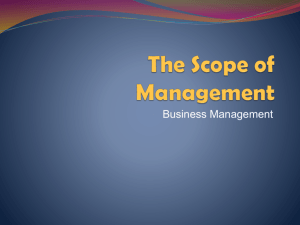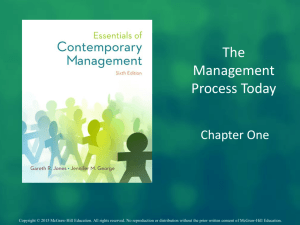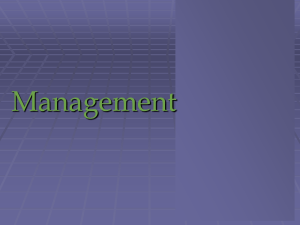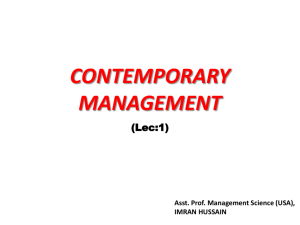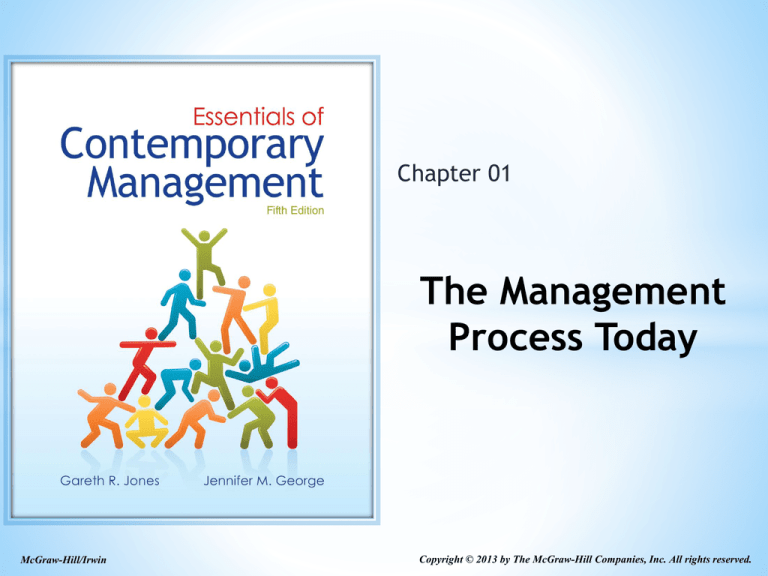
Chapter 01
The Management
Process Today
McGraw-Hill/Irwin
Copyright © 2013 by The McGraw-Hill Companies, Inc. All rights reserved.
Learning Objectives
• Describe what management is, why management is
important, what managers do, and how managers
use organizational resources efficiently and
effectively to achieve organizational goals
• Distinguish among planning, organizing, leading,
and controlling (the four principal managerial
tasks), and explain how managers’ ability to handle
each one affects organizational performance
1-2
Learning Objectives
• Differentiate among three levels of management,
and understand the tasks and responsibilities of
managers at different levels in the organizational
hierarchy
1-3
Learning Objectives
• Discuss some major changes in management
practices today that have occurred as a result of
globalization and the use of advanced information
technology (IT)
• Discuss the principal challenges managers face in
today’s increasingly competitive global
environment
1-4
Learning Objectives
• Describe what management is, why management is
important, what managers do, and how managers
use organizational resources efficiently and
effectively to achieve organizational goals
1-5
What is Management?
• Management: The planning, organizing, leading,
and controlling of human and other resources to
achieve organizational goals effectively and
efficiently
• “Getting work done through others”
• Organizations: Collections of people who work
together and coordinate their actions to achieve a
wide variety of goals
1-6
What is Management?
•
Managers
•
The people responsible for supervising the use of an
organization’s resources to meet its goals
•
Resources include:
•
People, skills, know-how, experience; machinery, raw
materials, computers and IT, patents, and financial
capital, and loyal customers and employees
1-7
Achieving High Performance
• Organizational performance: A measure of how
efficiently and effectively managers use
organizational resources to satisfy customers and
achieve goals
1-8
*
Efficiently
Getting work
done through
others
Effectively
1
9
Organizational Performance
Efficiency
•
A measure of how well
or productively
resources are used to
achieve a goal
•
Getting work done
with a minimum of
effort, expense, or
waste.
Effectiveness
•
A measure of the
appropriateness of the
goals an organization
is pursuing and the
degree to which they
are achieved
•
Accomplishing tasks
that help fulfill
organizational
objectives.
1-10
Figure 1.1 - Efficiency, Effectiveness,
and Performance in an Organization
1-11
Why Study Management?
•
Managers decide how to allocate society’s most valuable
resources effectively.
•
•
•
The more effective and efficient use an
organization can make of resources, the greater the relative
well-being of people
Studying management provides perspective on
understanding and learning to cope with bosses and
coworkers.
Students of management have the potential to compete
successfully for interesting and well-paying jobs.
• As managerial responsibility increases and people move
up the organization hierarchy, salaries grow with
responsibility.
•
The salaries paid to top managers and CEO are often quite large.
1-12
Learning Objective
• Distinguish among planning, organizing, leading,
and controlling (the four principal managerial
tasks), and explain how managers’ ability to handle
each one affects organizational performance
1-13
Figure 1.2 - Four Tasks of Management
1-14
Planning
• Process of identifying and selecting appropriate
goals and the courses of action to achieve the
goals.
• Includes 3 steps, collectively called a “Strategy”
•
•
•
Deciding which goals to pursue
Deciding what course of action to adopt to attain
those goals
Deciding how to allocate organizational resources
• The strategies determined during planning
determines the effectiveness and efficiency of an
organization.
1-15
Organizing
• Structuring working relationships so organizational
members interact and cooperate to achieve
organizational goals
• Deciding where decisions will be made
• Who will do what jobs and tasks
• Who will work for whom
• Organizational structure: A formal system of task
and reporting relationships that coordinates and
motivates organizational members so that they
work together to achieve organizational goals
1-16
Leading
• Articulating a clear vision and energizing and
enabling organizational members so they
understand the part they play in attaining
organizational goals
• Leadership involves managers using their power,
personality, influence, persuasion, and
communication skills to coordinate people and
groups so their activities and efforts are in
harmony.
• The outcome of leadership is a highly motivated
and committed workforce
1-17
Controlling
• Evaluating how well an organization is achieving its
goals and taking action to maintain or improve
performance
•
Outcome of the control process is the ability to
measure performance accurately and regulate
efficiency and effectiveness
•
Controlling helps managers evaluate how well they
are performing the other 3 tasks of management—
planning, organizing, and leading
1-18
*
Set standards to
achieve goals
Compare actual
performance to
standards
Make changes
to return
performance to
standards
2.4
19
Learning Objective
• Differentiate among three levels of management,
and understand the tasks and responsibilities of
managers at different levels in the organizational
hierarchy
1-20
Levels and Skills of Managers
• Managers are grouped in :
• Level or rank in the organization’s hierarchy
• Based on their specific job-related skills, expertise,
and experiences
• Department: A group of people who work together
and possess similar skills or use the same
knowledge, tools, or techniques to perform their
jobs
1-21
*
*
Top Managers
*
Middle Managers
*
First-Line Managers
*
Team Leaders
3
22
Levels and Skills of Managers
• First-line manager: Responsible for the daily
supervision of nonmanagerial employees
• Middle manager: Supervises first-line managers
and is responsible for finding the best way to use
resources to achieve organizational goals
• Top manager: Establishes organizational goals,
decides how departments should interact, and
monitors the performance of middle managers
• Team Leaders: Facilitate team performance,
Manage external relations and facilitate internal
team relationships
1-24
Figure 1.5 - Types and Levels of Managers
1-26
Top-Management Team
• Group composed of the CEO, COO, CFO, and the
heads of the most important departments
• Play a crucial role in determining an organization’s
long-term performance
• Creating a context for change
• Developing commitment
and ownership in employees
• Creating a positive organizational
culture through language and action
• Monitoring their business environments
1-27
*
*
Plant Manager
*
Regional Manager
*
Divisional Manager
3.2
3
28
*
Plan and allocate resources to meet objectives
Coordinate and link groups,
departments, and divisions
Monitor and manage the performance
of subunits and managers who report to them
Implement changes or strategies
generated by top managers
3.2
29
*
*
Office Manager
*
Shift Supervisor
*
Department Manager
3.3
3
30
*
Manage the performance of
entry-level employees
Encourage, monitor, and reward
the performance of workers
Teach entry-level employees how to do their jobs
Make detailed schedules and operating plans
3.3
31
Figure 1.4 - Relative Amount of Time That
Managers Spend on the Four Managerial Tasks
1-32
*
Interpersonal
Informational
Decisional
Figurehead
Monitor
Entrepreneur
Leader
Disseminator
Disturbance
Handler
Liaison
Spokesperson
Resource
Allocator
4
Negotiator
H. Mintzberg, “The Manager’s Job: Folklore and
33Fact:.” Harvard Business Review, July-August 1975.
*
Interpersonal Roles
Figurehead
Managers perform ceremonial duties
(welcome visitors, speak at opening
of new facilities, support local charities
Leader
Managers motivate and encourage
workers to accomplish objectives
Liaison
Managers deal with people outside
their units
4.1
34
*
Informational Roles
Monitor
Managers scan their environment
for information
Disseminator
Managers share information
with others in their company
Spokesperson
4.2
Managers share information
with others outside their
departments or companies
35
*
Decisional Roles
Entrepreneur
Managers adapt to incremental change
Disturbance
Handler
Managers respond to problems that
demand immediate action
Resource
Allocator
Negotiator
4.3
Managers decide who gets
what resources
Managers negotiate schedules,
projects, goals, outcomes, resources,
and raises
36
Learning Objective
• Distinguish among three kinds of managerial skill,
and explain why managers are divided into
different departments
1-37
Question?
Which management skill is the ability to understand,
alter, lead, and control the behavior of other
individuals and groups?
A. Conceptual
B. Human
C. Team
D. Technological
1-38
Skills Companies Look for in Managers
Conceptual skills: Ability to analyze and diagnose a
situation and distinguish between cause and effect
Human skills: Ability to understand, alter, lead,
and control the behavior of other individuals and
groups
Technical skills: The job-specific knowledge and
techniques required to perform an organizational
role
Core competency: Specific set of skills, abilities,
and experiences that allows one organization to
outperform its competitors
Motivation to Manage
An assessment of how motivated employees are to
tackle the management job.
1-39
Question?
What is the specific set of abilities that allows one
manager to perform at a higher level than another
manager?
A. Skill-sets
B. SKAs
C. Competencies
D. Skill traits
1-40
*
Managers’
Initial Expectations
Be the boss
Formal authority
Manage tasks
Job is not
managing people
After Six Months
As a Manager
Initial expectations were wrong
Fast pace
Heavy workload
After a Year
As a Manager
No longer “doer”
Communication,
listening, positive
reinforcement
Learning to adapt
Job is to be
and control stress
problem-solver
and troubleshooter Job is people
development
7
41
*
1. Insensitive to others
2. Cold, aloof, arrogant
3. Betrayal of trust
4. Overly ambitious
5. Specific performance problems with the business
6. Overmanaging: unable to delegate or build a team
7. Unable to staff effectively
8. Unable to think strategically
9. Unable to adapt to boss with different style
10. Overdependent on advocate or mentor
6
Adapted from
McCall & Lombardo, “What Makes a Top42
Executive?” Psychology Today, Feb 1983
Learning Objective
• Discuss some major changes in management
practices today that have occurred as a result of
globalization and the use of advanced information
technology (IT)
1-43
Recent Changes in Management
Practices
• Restructuring: Downsizing an organization by
eliminating the jobs of large numbers of top,
middle, and first-line managers and nonmanagerial
employees
• Modern IT has increased each person’s ability to
process information and make decisions more quickly
and accurately
1-44
Recent Changes in Management
Practices
• Outsourcing: Contracting with another company,
usually abroad, to have it perform an activity the
organization previously performed itself
• Increases efficiency because it lowers operating
costs, freeing up money and resources that can be
used in more effective ways
1-45
Empowerment
• The expansion of employees’ knowledge, tasks, and
decision-making responsibilities
•
Companies use their reward systems to promote
empowerment
•
IT is being increasingly used to empower employees
because it expands employees’ job knowledge and
increases the scope of their job responsibilities
1-46
Self-Managed Teams
• A group of employees who assume responsibility for
organizing, controlling, and supervising their own
activities and monitoring the quality of the goods
and services they provide
• Assume many tasks and responsibilities previously
performed by first-line managers, so a company
can better utilize its workforce
1-47
Global Organizations
• Organizations that operate and compete in more
than one country
1-48
Learning Objective
• Discuss the principal challenges managers face in
today’s increasingly competitive global
environment
1-49
Challenges for Management in
a Global Environment
• Building a competitive advantage
•
The ability of one organization to outperform other
organizations in producing goods or services more
efficiently and effectively
•
Companies can win or lose the competitive race
depending on their speed and flexibility
•
Innovation: Process of creating new or improved
goods and services or developing better ways to
produce or provide them
1-50
Challenges for Management in
a Global Environment
• Maintaining ethical standard
•
Pressure to increase performance can be healthy—
it leads managers to question how the organization
is working
•
Too much pressure to perform - induces managers
to behave unethically
1-51
Challenges for Management in
a Global Environment
• Managing a diverse workforce
•
•
Age, gender, race, ethnicity, religion, sexual
preference, and socioeconomic composition of the
workforce presents new challenges for managers
Establish procedures and practices that are legal,
fair, and equitable
• Utilizing new information systems and technologies
•
Managers have to continually find efficient and
effective ways to utilize new IT to better perform
jobs
1-52
Challenges for Management in
a Global Environment
• Practicing global crisis management involves
making important choices about how to:
•
Create teams to facilitate rapid decision making
and communication
•
•
•
Establish the organizational chain of command
Recruit and select the right people
Develop bargaining and negotiating strategies to
manage conflicts
1-53
*
Scientific Management
Studies and tests methods to identify
the best, most efficient ways
“Seat-of-the Pants” Management
No standardization of procedures
No follow-up on improvements
2
54
*
Frederick Taylor is known
today as the "father of
scientific management."
One of his many
contributions to modern
management is the
common practice of giving
employees rest breaks
throughout the day.
2.2
Frederick W. Taylor, 1856-1915
55
*
Frank and Lillian Gilbreth were prolific
researchers and often used their family as
guinea pigs. Their work is the subject of
Cheaper by the Dozen, written by their son
and daughter. Developed the use of motion
studies to simply work and improve
productive.
2.2
56
*
* Henry Gantt (1861-1919) was a protégé and then
an associate of Frederick Taylor.
* Gantt is best known for the Gantt chart, but also
made contributions to management with respect
to the training ,development, and rewarding of
workers.
57
*
2.3
58
*
Max Weber, 1864-1920
Proposed the idea of
bureaucratic organizations to
overcome the problems
associated with monarchies
and patriarchies.
Bureaucracy
The exercise of control on the basis of
knowledge, expertise, or experience.
3.1
59
*
1. Qualification-based hiring
2. Merit-based promotion
3. Chain of command
4. Division of labor
5. Impartial application of rules and procedures
6. Recorded in writing
7. Managers separate from owners
3.1
60
*
Mary Parker Follett is
known today as the
“mother of scientific
management." Her
many contributions to
modern management
include the ideas of
negotiation, conflict
resolution, and power
sharing.
4.1
Mary Parker Follett, 1868-1933
61
*
*Workers’ feelings and
attitudes affected their
work
*Financial incentives
weren’t the most
important motivator for
workers
*Group norms and
behavior play a critical
role in behavior at work
4.2
62
*
4.3
Chester Bernard-President of New Jersey Bell,
author of The Functions of the Executive.
Bernard wrote that the extent to which workers
willingly cooperate in an organization depends
how workers perceive authority and whether
they are willing to accept it.
People will be indifferent to managerial
directives if they…
* are understood
* are consistent with the purpose of the
organization
* are compatible with the people’s personal
interests
* can actually be carried
out by those people
63

